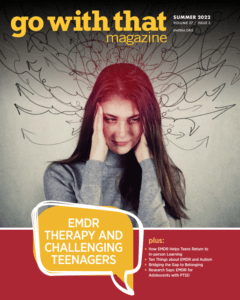EMDR therapy can help teenagers in many ways, from providing resources for grounding and stabilizing to reprocessing negative beliefs and traumatic events. Teenagers, maybe more than any other developmental age group are navigating SO much in their worlds. The cross over from childhood into adulthood involves changes that involve the brain being primed for flexibility, creativity, less inhibition and increased peer connection. Teens are learning and testing strategies to leave the home and become an adult, making what parents might think are questionable choices along the way. NOW add on top of these normal developmental changes: social media’s world of comparison, wading through multiple truths presented in a digital maze called the internet, a world wide pandemic, all while potentially facing a future of facing thousands of dollars of student loans or an uncertain employment future. Of course, there are happy milestones and celebrations as well, but as many teens and therapists that treat them know: the challenges are considerable when navigating this monumental life transition.

In our recent issue of Go With That Magazine™ focusing on the EMDR therapy during the teenage years, authors Annie Monaco, LCSW-R, RPT and Nicole E. Wolasz, LCSW-R discuss that working with teenagers can indeed be very challenging:
“Many teen clients are not interested in connecting to a strange adult, let alone doing something even stranger like EMDR…… Engaging teens toward change and healing often involves instilling hope and motivation, understanding what is important to the teen, exploring core issues, and involving parents and caregivers in the process. While all phases of EMDR are employed in working with teens, this article will focus on critical pieces needed for Phases 1, 2, and 4 of EMDR therapy, which are the foundation of effective trauma therapy for this age group. History taking, preparing, and engaging the family system will set the stage for good trauma processing.”
Click Here to Access Monaco & Wolasz’ GWT Article
Resources on EMDR with Adolescents
EMDR and Adolescents Books and Chapters: (Note that many resources cover wider developmental range)
Adler-Tapia, R. L. & Settle, C. S. (2017). EMDR and the art of psychotherapy with children: Infants to adolescents (2nd edition). New York: Springer Publishing Co.
Beckley-Forest, A., & Monaco, A. (2020). EMDR with children in the play therapy room: An integrated approach. New York, NY: Springer Publishing Co.
Gomez, A. M. (2013). EMDR therapy and adjunct approaches with children: Complex trauma, attachment and dissociation. New York, NY: Springer Publishing Co.
Gomez, A. M. (2018). Stories and storytellers: The thinking mind, the heart, and the body. Agate Books.
Greenwald, R. (2000). EMDR for traumatized children and adolescents. In K. N. Dwiveldi (Ed.), Post-traumatic stress disorder in children and adolescents. (pp.198-212.) London, England: Whurr.
Greenwald, R. (2006). Eye movement desensitization and reprocessing (EMDR) with traumatized youth. In N. Webb (Ed.), Helping traumatized children and youth in child welfare: Perspectives of mental health and children’s services practitioners. (pp. 246-264). New York, NY: Guilford Press
Greenwald, R. (2007). EMDR within a phase model of trauma-informed treatment. New York, NY: The Haworth Press, Routledge.
Greenwald, R. (2009). Treating problem behaviors: A trauma-informed approach. New York, NY: Routledge.
Lovett, J. (2015). Trauma-attachment tangle: Modifying EMDR to help children resolve trauma and develop loving relationships. New York, NY: Routledge.
Morris-Smith, J., & Silvestre, M. (2014). EMDR for the next generation: Healing children and families. (2nd Ed.) United Kingdom: Academic Publishing International Limited.
Shapiro, F., Wesselmann, D., & Mevissen, L. (2017). Eye movement desensitization and reprocessing therapy (EMDR). In M.A. Landolt, M. Cloitre, & U. Schnyder (Eds.), Evidence based treatments for trauma-related disorders in children and adolescents (pp. 273-298). NY: Springer.
Tinker, R. H., & Wilson, S. A. (1999). Through the eyes of a child: EMDR with children. New York, NY: Norton
Wesselmann, D. & Shapiro, F. (2013). Eye movement desensitization and reprocessing. In J. Ford & C. Courtois (Eds.) Treating complex traumatic stress disorders in children and adolescents (pp. 213-244). New York, NY: Guilford Press.
EMDR and Adolescents Peer-Reviewed Research Articles
Adler-Tapia, R. & Settle, C. (2009). Evidence of the efficacy of EMDR with children and adolescents in individual psychotherapy: A review of the research published in peer-reviewed journals. Journal of EMDR Practice and Research, 3(4), 232-247. Open access: https://doi.org/10.1891/1933-3196.3.4.232
Ahmad, A., & Sundelin-Wahlsten, V. (2008). Applying EMDR on children with PTSD. European Child & Adolescent Psychiatry, 17(3), 127-132. https://doi.org/10.1007/s00787-007-0646-8
Azimisefat, P., de Jongh, A., Rajabi, S., Kanske, P., & Jamshidi, F. (2022). Efficacy of virtual reality exposure therapy and eye movement desensitization and reprocessing therapy on symptoms of acrophobia and anxiety sensitivity in adolescent girls: A randomized controlled trial. Frontiers in Psychology. Open access: https://doi.org/10.3389/fpsyg.2022.919148
Bae, H., Kim, D., & Parke, Y. C. (2008). Eye movement desensitization and reprocessing for adolescent depression. Psychiatry Investigation. 5(1), 60-65. Open access: https://doi.org/10.4306/pi.2008.5.1.60
Barron, I. (2018). EMDR therapy with children and adolescents. Journal of EMDR Practice and Research, 12(4), p. 174-176. Open access: http://dx.doi.org/10.1891/1933-3196.12.4.174
Barron, I., Bourgaize, C., Lempertz, D., Swinden, C., & Darker-Smith, S. (2019). Eye movement desensitization reprocessing for children and adolescents with posttraumatic stress disorder: A systematic narrative review. Journal of EMDR Practice and Research, 13(4), 270-283. Open access: http://dx.doi.org/10.1891/1933-3196.13.4.270
Bastien, R. J., Jonsma, H., Kabadayi, M., & Billings, J. (2020). The effectiveness of psychological interventions for post-traumatic stress disorder in children, adolescents and young adults: A systematic review and meta-analysis. Psychological Medicine, 50(10), 1598-1612. https://doi.org/10.1017/S0033291720002007
Becker, J., Greenwald, R., & Mitchell, C. (2011). Trauma-informed treatment for disenfranchised urban children and youth: An open trial. Child & Adolescent Social Work Journal, 28(4), 257-272. https://doi.org/10.1007/s10560-011-0230-4
Beer, R., (2018). Efficacy of EMDR therapy for children with PTSD: A review of the literature. Journal of EMDR Practice and Research, 12(4), 177-195. Open access: http://dx.doi.org/10.1891/1933-3196.12.4.177
Bennet, R. S., Denne, M., McGuire, R., & Hiller, R. M. (2020). A systematic review of controlled trials for PTSD in maltreated children and adolescents. Child Maltreatment, 1-19. https://doi.org/10.1177/1077559520961176
Bucan-Varatanovic, A., & Sabanovic, S. (2021). The application of EMDR therapy in treating adolescents with the adjustment disorder: A case report. Psychiatria Danubina, 33(Suppl 1), 49-53. http://www.psychiatria-danubina.com/2021-vol-33-sup-1/2354?tip=&datum_od=&datum_do=&detalji=2354&z=&page=2
Chemtob, C. M., Nakashima, J., & Carlson, J. G. (2002). Brief-treatment for elementary school children with disaster-related PTSD: A field study. Journal of Clinical Psychology, 58, 99-112. https://doi.org/10.1002/jclp.1131
Chen, R., Gillespie, A., Zhao, Y., Xi, Y., Ren, Y., & McLean, L. (2018). The efficacy of eye movement desensitization and reprocessing in children and adults who have experienced complex childhood trauma: A systematic review of randomized controlled trials. Frontiers in Psychology, 9, 534. Open access: https://doi.org/10.3389/fpsyg.2018.00534
Civilotti, C., Margola, D., Zaccagnino, M., Cussino, M., Callerame, C., Vicini, A., & Fernandez, I. (2021). Eye movement desensitization and reprocessing in child and adolescent psychology: A narrative review. Current Treatment Options in Psychiatry, 8, 95-109. Open access: https://doi.org/10.1007/s40501-021-00244-0
Cuismano, A., (2018). EMDR in the treatment of adolescent obsessive-compulsive disorder: A case study. Journal of EMDR Practice and Research, 12(4), 242-254. Open access: http://dx.doi.org/10.1891/1933-3196.12.4.242
de Roos, C., & de Jongh, A. (2008). EMDR treatment of children and adolescents with a choking phobia. Journal of EMDR Practice and Research, 2(3), 201-211. Open access: https://doi.org/10.1891/1933-3196.2.3.201
de Roos, C., Greenwald, R., den Hollander-Gijsm, M., Noorthoorn, E., van Buuren, S., & de Jongh, A. (2011). A randomized comparison of cognitive behavioural therapy (CBT) and eye movement desensitization and reprocessing (EMDR) in disaster-exposed children. European Journal of Psychotraumatology, 2, 5694-704. Open access: https://doi.org/10.3402/ejpt.v2i0.5694
de Roos, C., Rommelse, N., Donders, R., Knipschild, R., Bicanic, I,. & de Jongh, A. (2019). Response to “Comparing the effectiveness of EMDR and TF-CBT for children and adolescents: A meta-analysis.” Journal of Child & Adolescent Trauma, 1-3. https://doi.org/10.1007/s40653-019-00257-1
de Roos, C., van der Oord, S., Zijlstra, B., Lucassen, S., Perrin, S., Emmelkamp, P. & De Jongh, A. (2017). Comparison of eye movement desensitization and reprocessing therapy, cognitive behavioral writing therapy, and wait-list in pediatric posttraumatic stress disorder following single-incident trauma: a multicenter randomized clinical trial. Journal of Child Psychology and Psychiatry, 58(11), 1219-1228. https://doi.org/10.1111/jcpp.12768
Diehle, J., Opmeer, B. C., Boer, F., Mannarino, A. P., & Lindauer, R. J. (2015). Trauma-focused cognitive behavioral therapy or eye movement desensitization and reprocessing: What works in children with posttraumatic stress symptoms? A randomized controlled trial. European Child & Adolescent Psychiatry, 24(2), 227-236. https://doi.org/10.1007/s00787-014-0572-5
Dorsey, S., McLaughlin, K. A., Kerns, S. U., Harrison, J. P., Lambert, H. K., Briggs, E. C., Cox, J. R., & Amaya-Jackson, L. (2017). Evidence Base Update for Psychosocial Treatments for Children and Adolescents Exposed to Traumatic Events. Journal of Clinical Child & Adolescent Psychology, 46 (3), 303-330. Open access: https://doi.org/10.1080/15374416.2016.1220309
Farkas, L., Cyr, M., Lebeau, T., & Lemay, J. (2010). Effectiveness of MASTR/EMDR therapy for traumatized adolescents with conduct problems. Journal of Child & Adolescent Trauma, 3(2), 125-142. https://doi.org/10.1080/19361521003761325
Field, A., & Cottrell, D. (2011). Eye movement desensitization and reprocessing as a therapeutic intervention for traumatized children and adolescents: A systematic review of the evidence for family therapists. Journal of Family Therapy, 33(4), 374-388. https://doi.org/10.1111/j.1467-6427.2011.00548.x
Fleming, J. (2012). The effectiveness of eye movement desensitization and reprocessing in the treatment of traumatized children and youth. Journal of EMDR Practice and Research, 6(1), 16-26. Open access: https://doi.org/10.1891/1933-3196.6.1.16
Gillies, D., Maiocchi, L., Bhandari, A P., Taylor, F., Gray, C., & O’Brien, L. (2016). Psychological therapies for children and adolescents exposed to trauma. Cochrane Database of Systematic Reviews, 10, CD012371. Open access: https://doi.org/10.1002/14651858.CD012371
Gillies, D., Taylor, F., Gray, C., O’Brien, L., & D’Abrew, N. (2013). Psychological therapies for the treatment of post-traumatic stress disorder in children and adolescents (Review). Evidence-Based Child Health: A Cochrane Review Journal, 8(3), 1004-1116. https://doi.org/10.1002/ebch.1916
Greenwald, R. (2000). A trauma-focused individual therapy approach for adolescents with conduct disorder. International Journal of Offender Therapy and Comparative Criminology, 44(2), 146-163. https://doi.org/10.1177/0306624X00442002
Greenwald, R. (2002). Motivation-adaptative skills-trauma resolution (MASTR) therapy for adolescents with conduct problems: An open trial. Journal of Aggression, Maltreatment, & Trauma, 6(1), 237-261. https://doi.org/10.1300/J146v06n01_12
Greenwald, R. (2014). Intensive child therapy to prevent further abuse victimization: A case study. Journal of Child Custody, 11(4), 325-334. https://doi.org/10.1080/15379418.2014.990128
Greenwald, R., Siradas, L., Schmitt, T. A., Resland, S., Sande, B., & Fierle, J. (2012). Implementing trauma-informed treatment for youth in a residential facility: First year outcomes. Residential Treatment for Children and Youth, 29(2), 141-153. https://doi.org/10.1080/0886571X.2012.676525
Greyber, L., Dulmus, C., & Cristalli, M. (2012). Eye movement desensitization reprocessing, post traumatic stress disorder, and trauma: A review of randomized controlled trials with children and adolescents. Child and Adolescent Social Work Journal, 29(5), 409-425. https://doi.org/10.1007/s10560-012-0266-0
Hensel, T. (2009). EMDR with children and adolescents after single-incident trauma: An intervention study. Journal of EMDR Practice and Research, 3(1), 2-9. Open access: https://doi.org/10.1891/1933-3196.3.1.2
Hofel, L., Eppler, B., Storf, M., Schnobel-Muller, E., Haas, J. P., & Hugle, B. (2018). Successful treatment of methotrexate intolerance in juvenile idiopathic arthritis using eye movement desensitization and reprocessing – treatment protocol and preliminary results. Pediatric Rheumatology, 16,11. Open access: https://doi.org/10.1186/s12969-018-0228-y
Hofmann, F., Goihl, M., Hase, M., & Hase, A. (2021). Trauma Psycho Social Support Plus ® and EMDR therapy for children and adolescents in a post-conflict setting: Mental health training in Kurdistan. Torture: Journal on Rehabilitation of Torture Victims and Prevention of Torture, 31(1). Open access: https://doi.org/10.7146/torture.v31i1.123492
Hogberg, G., & Hallstrom, T. (2008). Active multimodal psychotherapy in children and adolescents with suicidality: Description, evaluation and clinical profile. Clinical Child Psychology and Psychiatry, 13(3), 435-448. https://doi.org/10.1177/1359104507088348
Hoogsteder, L. M., ten Thije, L., Schippers, E. E., & Stams, G. J. J. M. (2021). A meta-analysis of the effectiveness of EMDR and TF-CBT in reducing trauma symptoms and externalizing behavior problems in adolescents. International Journal of Offender therapy and Comparative Criminology. https://doi.org/10.1177/0306624X211010290
Jaberghaderi, N., Greenwald, R., Rubin, A., Dolatabadim, S., & Zand, S. O. (2004). A comparison of CBT and EMDR for sexually abused Iranian girls. Clinical Psychology and Psychotherapy, 11, 358-368. https://doi.org/10.1002/cpp.395
Jaberghaderi, N., Rezaei, M., Kolivand, M., & Shokoohi, A. (2019). Effectiveness of cognitive behavioral therapy and eye movement desensitization and reprocessing in child victims of domestic violence. Iranian Journal of Psychiatry, 14(1), 67-75. Open access: https://doi.org/10.18502/ijps.v14i1.425
Jimenez, G., Becker, Y., Varela, C., Garcia, P., Nuno, M. A., Perez, M. C., Osorio, A., Jarero, I., & Givaudan, M. (2020). Multicenter randomized controlled trial on the provision of the EMDR-PRECI to female minors victims of sexual and/or physical violence and related PTSD diagnosis. American Journal of Applied Psychology, 9(2), 42-51. DOI: 10.11648/j.ajap.20200902.12. Open access: http://www.sciencepublishinggroup.com/journal/paperinfo?journalid=203&doi=10.11648/j.ajap.20200902.12
John-Baptiste Bastien, R., Jongsma, H. E., Kabadayi, M., & Billings, J. (2020). The effectiveness of psychological interventions for post-traumatic stress disorder in children, adolescents, and young adults: A systematic review and meta-analysis. Psychological Medicine. https://doi.org/10.1017/S0033291720002007
Karadag, M., Gokcen, C., & Sarp, A. S. (2019). EMDR therapy in children and adolescents who have post-traumatic stress disorder: A six-week follow-up study. International Journal of Psychiatry in Clinical Practice, 24(1), 77-82. https://doi.org/10.1080/13651501.2019.1682171
Karadag, M., & Gunel Karadeniz, P. (2021). Comparison of group eye movement desensitization and reprocessing with cognitive and behavioral therapy protocol after the 2020 earthquake in Turkey: A field study in children and adolescents. European Journal of Therapeutics, 27(1), 40-44. Open access: http://doi.org/10.5152/eurjther.2021.20056
Kokanovic, I., & Hasanovic, M. (2018). Would the well-timed use of EMDR therapy in the school system save the mental health of youth? Case reports. Psychiatria Danubina, 30(Suppl 5), 276-281. http://www.psychiatria-danubina.com/2018-vol-30-sup-5/1442?tip=&datum_od=&datum_do=&detalji=1442&z=&page=3
Lewey, J. H., Smith, C. L., Burcham, B., Saunders, N. L., Elfallal, D., & O’Toole, S. K. (2018). Comparing the effectiveness of EMDR and TF-CBT for children and adolescents: A meta-analysis. Journal of Child & Adolescent Trauma, 11(4), 457-472. https://doi.org/10.1007/s40653-018-0212-1
Lovelle, C. (2008). Dialectical behavioral therapy and EMDR for adolescents in residential treatment: A practical and theoretical perspective. Residential Treatment for Children & youth, 23(102), 27-43. https://doi.org/10.1300/J007v23n01_03
Manzoni, M., Fernandez, I., Bertella, S., Tizzoni, F., Gazzola, E., Molteni, M., & Nobile, M. (2021). Eye movement desensitization and reprocessing: The state of the art of efficacy in children and adolescent with post traumatic stress disorder. Journal of Affective Disorders, 282(1), 340-347. https://doi.org/10.1016/j.jad.2020.12.088
Maroufi, M., Zamani, S., Izadikhah, Z., Marofi, M., & O’Connor, P. (2016). Investigating the effect of eye movement desensitization and reprocessing (EMDR) on postoperative pain intensity in adolescents undergoing surgery: A randomized controlled trial. Journal of Advanced Nursing, 72(9), 2207-2217. https://doi.org/10.1111/jan.12985
Meentken, M. G., van Beynum, I. M., Aendekerk, E. W. C., Legerstee, J. S., El Marroun, H., van der Ende, J., Lindauer, R. J. L., Hillegers, M. H. J., Moll, H. A., Helbing, W. A., & Utens, E. M. W. J. (2018). Eye movement desensitization and reprocessing (EMDR) in children and adolescents with subthreshold PTSD after medically related trauma: Design of a randomized controlled trial. European Journal of Psychotraumatology, 9, 1:536287. Open access: https://doi.org/10.1080/20008198.2018.1536287
Meentken, M. F., van der Mheen, M., van Beynum, I. M., Aendekerk, E. W. C., Legerstee, J. S., van der Ende, J., del Canho, R., Lindauer, R. J. L., Hillegers, M. H. J., Helbing, W. A., Moll, H. A., & Utens, E. M. W. J. (2021). Long-term effectiveness of eye movement desensitization and reprocessing in children and adolescents with medically related subthreshold post-traumatic stress disorder: A randomized controlled trial. European Journal of Cardiovascular Nursing, zvaa006. Open access: https://doi.org/10.1093/eurjcn/zvaa006
Moreno-Alcázar, A., Treen, D., Valiente-Gómez, A., Sio-Eroles, A., Pérez, V., Amann, B. L., & Radua, J. (2017). Efficacy of eye movement desensitization and reprocessing in children and adolescent with post-traumatic stress disorder: A meta-analysis of randomized controlled trials. Frontiers in Psychology, 8:1750. Open access: https://doi.org/10.3389/fpsyg.2017.01750
Ooms-Evers, M., van der Graaf-Loman, S., van Duijvenbode, N., Mevissen, L., & Didden, R. (2021). Intensive clinical trauma treatment for children and adolescents with mild intellectual disability or borderline intellectual functioning: A pilot study. Research in Developmental Disabilities, 117, 104030. Open access: https://doi.org/10.1016/j.ridd.2021.104030
Paauw, C., de Roos, C., Tummers, J., de Jongh, A., & Dingemans, A. (2019). Effectiveness of trauma-focused treatment for adolescents with major depressive disorder. The European Journal of Psychotraumatology, 10(1), 1682931. Open access: https://doi.org/10.1080/20008198.2019.1682931
Pasalic, M. (2021). EMDR treatment of conduct problems in adolescent: Case report. Psychiatria Danubina, 33(Suppl 1), 54-58. http://www.psychiatria-danubina.com/2021-vol-33-sup-1/2354?tip=&datum_od=&datum_do=&detalji=2354&z=&page=3
Puffer, M., Greenwald, R., & Elrod, D. (1998). A single session EMDR study with twenty traumatized children and adolescents. Traumatology, 3(2). https://doi.org/10.1037/h0101053
Reynolds, S., Wilson, C., Austin, J., & Hooper, L. (2012). Effects of psychotherapy for anxiety in children and adolescents: A meta-analytic review. Clinical Psychology Review, 32(4), 251-262. https://doi.org/10.1016/j.cpr.2012.01.005
Roque-Lopez, S., Llanez-Anaya, E., Alvarez-Lopez, M. J., Everts, M., Fernandez, D., Davidson, R. J., & Kaliman, P. (2021). Mental health benefits of a 1-week intensive multimodal group program for adolescents with multiple adverse childhood experiences. Child Abuse & Neglect, 122, 105349. Open access: https://doi.org/10.1016/j.chiabu.2021.105349
Scheck, M., Schaeffer, J. A., & Gillette, C. S. (1998). Brief psychological intervention with traumatized young women: The efficacy of eye movement desensitization and reprocessing. Journal of Traumatic Stress, 11(1), 25-44. https://doi.org/10.1023/A:1024400931106
Simmons, C., Meiser-Stedman, R., Baily, H., & Beazley, P. (2021). A meta-analysis of dropout from evidence-based psychological treatment for post-traumatic stress disorder (PTSD) in children and young people. European Journal of Psychotraumatology, 12(1), 1947570. Open access: https://doi.org/10.1080/20008198.2021.1947570
Smyth-Dent, K. L., Fitzgerald, J., & Hagos, Y. (2019). A field study on the EMDR integrative group treatment protocol for ongoing traumatic stress provided to adolescent Eritrean refugees living in Ethiopia. Psychology and Behavioral Science International Journal, 12(4), 1-12. Open access: https://juniperpublishers.com/pbsij/pdf/PBSIJ.MS.ID.555842.pdf
Soberman, G. B., Greenwald, R., & Rule, D. L. (2002). A controlled study of eye movement desensitization and reprocessing (EMDR) for boys with conduct problems. Journal of Aggression, Maltreatment, and Trauma, 6(1), 217-236. https://doi.org/10.1300/J146v06n01_11
Stewart, K. L, & Bramson, T. (2008). Incorporating EMDR in residential treatment. Residential Treatment for Children & Youth, 17(4), 83-90. https://doi.org/10.1300/J007v17n04_07
Taylor, A., & McLachlan, N. H. (2019). Treating a 16 year old with a history of severe bullying: Supplementing cognitive behavioral therapy with EMDR within the context of a case formulation approach. Journal of Child & Adolescent Trauma, 12(4), 561-570. https://doi.org/10.1007/s40653-019-00258-0
Teke, E., & Avsaroglu, S. (2022). Efficacy of eye movement desensitization and reprocessing (EMDR) therapy for children and adolescents with post-traumatic stress disorder. Journal of School and Educational Psychology, 2(1), 1-12. Open access: https://doi.org/10.47602/josep.v2i1.1. Retrieved from: https://journalofschoolpsychology.com/index.php/josep/article/view/1
van Pelt, Y., Fokkema, P., de Roos, C., & de Jongh, A. (2021). Effectiveness of an intensive treatment programme combining prolonged exposure and EMDR therapy for adolescents suffering from severe post-traumatic stress disorder. European Journal of Psychotraumatology, 12(1), 1917876. Open access: https://doi.org/10.1080/20008198.2021.1917876
Verardo, A. R., & Cioccolanti, E. (2017). Traumatic experiences and EMDR in childhood and adolescence. A review of the scientific literature on efficacy studies. Clinical Neuropsychiatry, 14(5), 313-320. Open access: https://www.clinicalneuropsychiatry.org/clinical-neuropsychiatry-volume-14-issue-5-october-2017/
Vucina, T. (2021). EMDR treatment of phobia of thirteen years old girl – case study. Psychiatria Danubina, 33(Suppl 1), 46-48. http://www.psychiatria-danubina.com/2021-vol-33-sup-1/2354?tip=&datum_od=&datum_do=&detalji=2354&z=&page=2
Whitson, M. L., Champine, R. B., Griffin, A., Corto-Mergins, C. Lusa, J., Jaffe, F, Hemmelgarn, A., Bryden, E., Clark, K., & Kaufman, J. S. (2020). Impact of an integrated EMDR treatment program for children and youth exposed to potentially traumatic events: The village collaborative trauma center. (2020). The Journal of EMDR Practice and Research, 14(3). Open access: http://dx.doi.org/10.1891/EMDR-D-20-00002
Xiang, Y., Cipriani, A., Teng, T., Del Giovane, C., Zhang, Y., Weisz, J. R., Li, X., Cuijpers, P., Liu, X., Barth, J., Jiang, Y., Cohen, D., Fan, L., Gillies, D., Du, K., Ravindran, A. V., Zhou, X., & Xie, P. (2021). Comparative efficacy and acceptability of psychotherapies for post-traumatic stress disorder in children and adolescents: A systematic review and network meta-analysis. Evidence-Based Mental Health, 24, 153-160. Open access: http://dx.doi.org/10.1136/ebmental-2021-300346
Back to Focal Point Blog Homepage
Additional Resources
If you are a therapist interested in the EMDR training:
- Learn more about EMDR at the EMDRIA Library
- Learn more about EMDR Training
- Search for an EMDR Training Provider
- Check out our EMDR Training FAQ
If you are EMDR trained:
- Check out EMDRIA’s Let’s Talk EMDR Podcast
- Check out the EMDRIA blog, Focal Point
- Learn more about EMDRIA membership
- Search for Continuing Education opportunities
If you are an EMDRIA Member:
Date
September 9, 2022
Client Population
Adolescents





